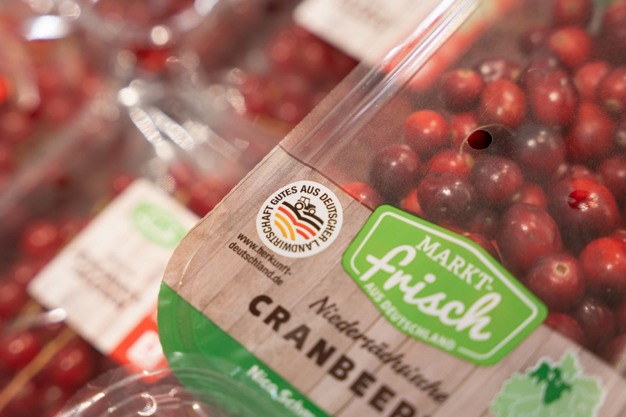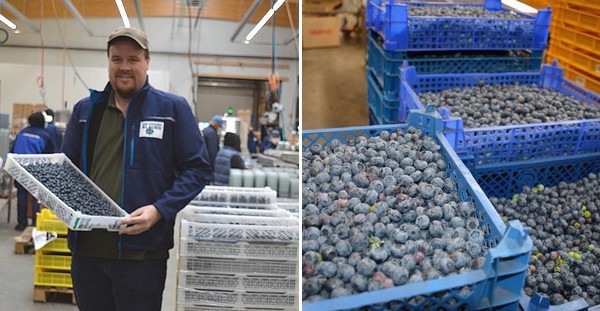While the German soft fruit campaign is now drawing to a close, the domestic cranberry season is only just picking up speed. Since mid-September, the specialised producer Nico Schmuck in Gilten, Lower Saxony, has been busy harvesting on around 20 hectares. "As with many other products, the cranberry harvest started two weeks earlier than usual this year. I would describe the quantities so far as average: There are a lot of berries hanging on the bushes, but mostly smaller ones. However, this is not a disadvantage in terms of marketing. We are talking about a difference of only 1–2 millimetres compared to the average size, which has no influence on the quality of the berries," says Christiaan Koellreuter, Managing Director of the exclusive marketing partner Nordgemüse GmbH.
Great complementary product
In previous years, cranberries from Lower Saxony were mainly found in 200 and 250g trays in food retailers. "This year, however, 400 and 500g trays are also available in many places, as it has been realised that the small formats are not sufficient for sauces for game dishes. These large formats have therefore already proved popular." According to Koellreuter, this also applies to German cranberries in general. "We have been marketing this product for two decades now and have seen slight growth in recent years. Although it is a niche, it is still growing slightly. For us, i.e. from the marketer's perspective, the cranberry is also a great complementary product to blueberries in autumn."
Cranberries are extremely care-intensive and demanding to grow, continues Koellreuter. "Although parts of our plant were flooded in spring, the wet conditions did not cause any significant damage. The consequences of the dry phase in early summer were all the greater, which ultimately led to the smaller fruits. In addition, the lack of cool nights contributed to the fact that some of the berries were not as beautifully coloured as last year." The cranberries are usually available until mid-November, followed by overseas goods from the USA and Canada, which in turn are marketed until the turn of the year.

Lower Saxony cranberries from producer Nico Schmuck are now listed in almost all well-known food retail chains in Germany, including Kaufland. German cranberries are also exported to neighbouring countries, including Switzerland, Slovakia, and Austria.
Tight supply situation characterises blueberry market
Meanwhile, the blueberry market has switched almost completely to produce from the Southern Hemisphere. Koellreuter: "The Polish and Ukrainian seasons are now practically over, while produce from South Africa, Zimbabwe, Namibia, Peru, and Argentina is gradually arriving on the market. Although the start of the season in South Africa went according to plan, a prolonged cold spell with snowfall in parts of the country severely affected exports. This year, for the first time, we are marketing produce from our own plantation in Namibia, which was only planted last year. However, the quantities are still modest. The biggest problem is the delay in the Peruvian main harvest: El Niño has extended last year's season to March instead of January, which is why the new season will now only get going in 1–2 months, i.e. in November or at worst even December. Until then, we can expect the supply situation to remain tight."
 According to Koellreuter, the market situation is expected to recover as soon as Peruvian blueberry exports pick up, followed later by the first volumes from Chile and Morocco.
According to Koellreuter, the market situation is expected to recover as soon as Peruvian blueberry exports pick up, followed later by the first volumes from Chile and Morocco.
In line with the limited availability, small formats of between 125 and 300 grams are currently predominant in food retail. Promotions with large formats are not possible at this time. "There is simply not enough quantity for this," Koellreuter confirms. Prices are also at a high level, which in turn is due to the continued rise in costs. "Overall, however, we continue to see an unabated high demand for cultivated blueberries."
For more information:
Christiaan Koellreuter
Nordgemüse Krogmann GmbH & Co KG.
An der Autobahn 50
29690 Buchholz/ Aller
Phone: +49 (0) 5071 / 96 80 00
E-Mail: [email protected]
www.nordgemuese.de
